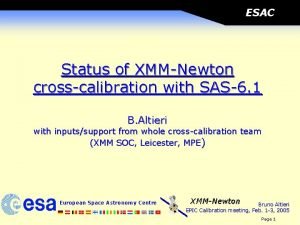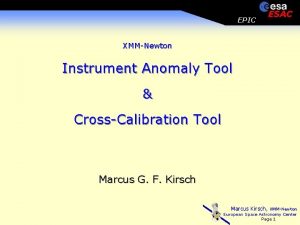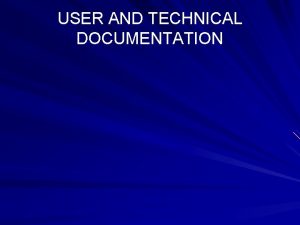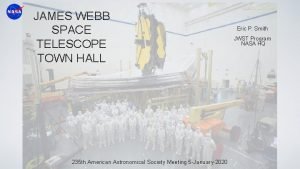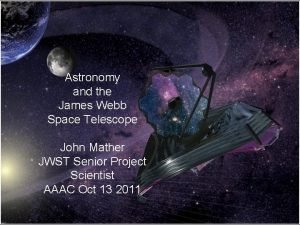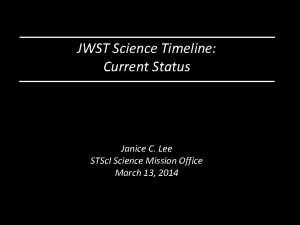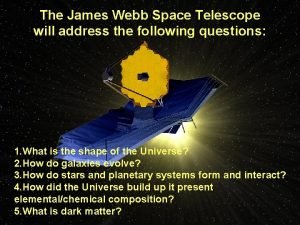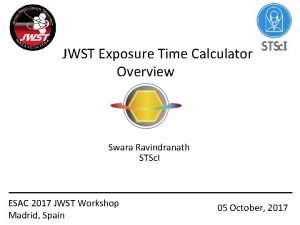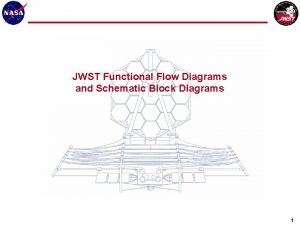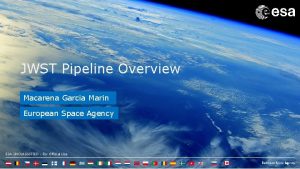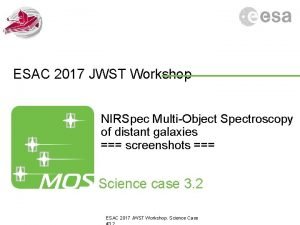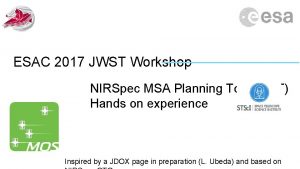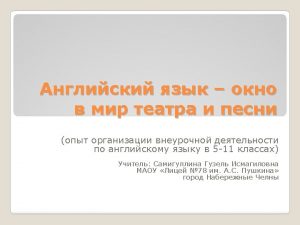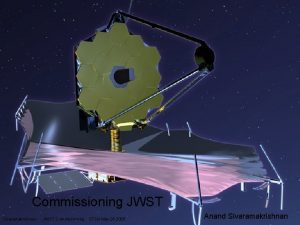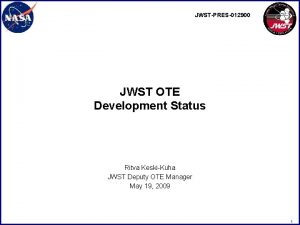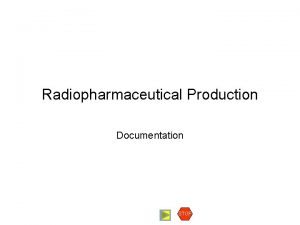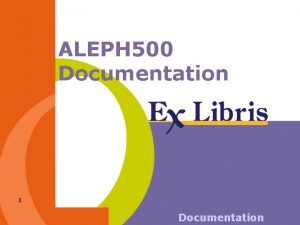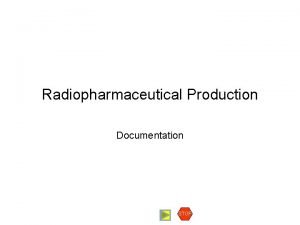ESAC 2017 JWST Workshop JWST User Documentation Hands



















- Slides: 19

ESAC 2017 JWST Workshop JWST User Documentation Hands on experience With Answers

Introduction https: //jwst-docs. stsci. edu Disclaimer: the JWST User documentation is under revision; current versions are preliminary and subject to revision.

Part -1 N. 1 Question When are cycle 1 GO proposal due ? I want to use JWST to image a faint object near a bright object, specifically an exoplanet near its host star. What JWST instruments and observing modes are available to me? 2 What wavelength ranges do they operate in? I would like to take multi-object spectroscopy (MOS) of known galaxies within a JWST field-of-view. What instrument should I use to achieve this? 3 Can I observe with another instrument in parallel to obtain images of an adjacent area of the sky? How about grism spectroscopy? Your answer

Part -2 N. Question What is spatial resolution for the NIRCAM short and long wavelength channels? 4 What is the approximate gap in arcseconds of the field of view of the two NIRCAM modules ? 5 Which JWST instruments offer integral field unit (IFU) observations? What wavelengths are covered by these instrument modes? 6 I want to use slitless spectroscopy to obtain spectra of every object within a JWST field-of-view in the wavelength range between 0. 8 – 2. 2 µm. What instrument and observing mode should I use? What about in the wavelength range between 2. 4 – 5. 0 µm. ? Your answer

Part -3 N. 7 8 9 10 Question What is the resolution and wavelength coverage of the various time series observation (TSO) spectroscopic modes offered on JWST? I see Special Requirements in APT, but not sure what my options are. What are the four general categories for special requirements? How do I perform multiple calculations in ETC to explore a parameter space (filters, or exposure parameters) for a given scene ? What are “Target Groups” in APT and is this option supported for all modes? Your answer

Go to the questions for the instrument you are mostly interested in MIRI specific questions – PART 4 NIRSpec specific questions – PART 5 NIRISS specific questions – PART 6 NIRCAM specific questrions – PART 7

Part -4 - MIRI N. MIR-1 MIR-2 MIR-3 MIR-4 Question I want to obtain a mid-infrared spectrum that has complete coverage from 4. 9 – 28. 45 µm at a resolution R > 1500. Can I do this in one observation? If now, how many separate observations do I need? I see Special Requirements in APT, but not sure what my options are. What are the four general categories for special requirements? Which MIRI observing modes require target acquisition (TA)? Are there modes where I do not need to perform a TA? I want to take a MIR image of a source that has a flux density of 80 m. Jy at 5. 6 µm. Should I use a subarray to not saturate the detector, and if so, which one? What detector readout pattern should I use? Your answer

Part -5 - NIRSpec N. NRS-1 NRS-2 NRS-3 NRS-4 Question I want to observe emission features in NIRSpec from 1. 5 to 5 micron range at the highest spectral resolution possible. Which instrument settings should I use? Can I do this in one setting? Which NIRSpec detector readout has better noise performance? Can I use this mode for subarrays? When do I need to take a NIRSpec “leakage exposure”? How can I mitigate leakage? How do I plan NIRSpec MOS observations? What relative astrometry do I need, and can I observe in this mode if my catalog doesn’t have such precise positions? Your answer

Part -6 - NIRISS N. Question NIS-1 NIRISS has two grisms for slitless spectroscopy. What are they and what’s the difference? NIS 2 What is the resolution and wavelength coverage of the 2 nd order for the NIRISS SOSS mode? NIS-3 When should I propose for NIRISS imaging instead of NIRCam imaging? NIS-4 What separation can achieve between bright host and faint companion for the NIRISS Aperture Masking Interferometry (AMI) mode? Your answer

Part -7 - NIRCAM N. Question NIR-1 What is NIRCam FOV? NIR-2 What dither pattern do I use to cover the NIRCam imager module gap? NIR-3 NIR-4 What is the NIRCam pixel scale in the short wavelength (SW) channel and the long wavelength (LW) channel? What’s the wavelength coverage of these channels? For a NIRCam integration in APT or ETC, I see a number of variables necessary to specify my observation. My source is faint. Is it better to obtain a single exposure with multiple integrations, or multiple exposures with one integration? Your answer

ANSWERS

NOTEs: links only work in presentation mode N. Question 1 When are cycle 1 GO proposal due ? 2 I want to use JWST to image a faint object near a bright object, specifically an exoplanet near its host star. What JWST instruments and observing modes are available to me? What wavelength ranges do they operate in? Answer March 2, 2018 MIRI (coronagraph) NIRCAM (Coronograph) NIRISS (AMI) NIRCam coronagraphy; wavelengths depend on mask. Available ranges: 1. 8 - 2. 12 µm 3. 0 - 3. 56 µm 4. 10 - 4. 60 µm 1. 7 - 2. 2 µm 2. 4 - 5. 0 µm MIRI coronagraphy; central wavelengths of available filters 10. 575 µm 11. 40 µm 15. 5 µm 22. 75 µm NIRISS aperture masking interferometry; central wavelengths of available filters 3. 8 µm 4. 3 µm 4. 8 µm

NOTEs: links only work in presentation mode N. 3 Question Answer I would like to take multi-object spectroscopy (MOS) of known galaxies within a JWST field-of-view. What instrument should I use to achieve this? NIRSpec Can I observe with another instrument in parallel to obtain images of an adjacent area of the sky? In Cycle 1, NIRCam imaging can be performed in parallel to NIRSpec MOS, but grism spectroscopy is not allowed. How about grism spectroscopy? 4 What is spatial resolution for the NIRCAM short and long wavelength channels? What is the approximate gap in arcseconds of the field of view of the two NIRCAM modules ? 5 Which JWST instruments offer integral field unit (IFU) observations? 0. 031”/pixel and 0. 063”/pixel respectively ~45” MIRI medium resolution spectroscopy (MRS); 4. 9 – 28. 8 µm What wavelengths are covered by these instrument modes? NIRSpec; 0. 6 – 5. 3 µm

NOTEs: links only work in presentation mode N. 6 Question I want to use slitless spectroscopy to obtain spectra of every object within a JWST field-of-view in the wavelength range between 0. 8 – 2. 2 µm. What instrument and observing mode should I use? Answer NIRISS wide field slitless spectroscopy (WFSS) NIRCam wide field slitless spectroscopy (WFSS) What about in the wavelength range between 2. 4 – 5. 0 µm. ? 7 What is the resolution and wavelength coverage of the various time series observation (TSO) spectroscopic modes offered on JWST? NIRISS single object slitless spectroscopy (SOSS): R ~ 700, 0. 9 – 2. 8 µm MIRI Low Resolution Spectroscopy (LRS): R~40 at 5 µm, 160 at 10 µm NIRCam grism time series: R ~ 1500, 2. 4 – 5. 0 µm NIRSpec Bright Object Time series: R ~ 100, 0. 6 – 5. 3 µm; R ~ 1000 or 2700 (depending on disperser) for wavelength ranges 0. 7 – 1. 27 µm 0. 97 – 1. 89 µm 1. 66 – 3. 17 µm 2. 87 – 5. 27 µm 8 I see Special Requirements in APT, but not sure what my options are. What are the four general categories for special requirements? Timing, Position Angle, Moving Targets, Miscellaneous

NOTEs: links only work in presentation mode N. 9 10 Question How do I perform multiple calculations in ETC to explore a parameter space (filters, or exposure parameters) for a given scene ? What are “Target Groups” in APT and is this option supported for all modes? Answer Use Batch Expansion. Closely-spaced fixed targets that should be observed together and have the same exposure and observation specifications. This option is only supported for the MIRI LRS, MIRI MRS, NIRSpec Fixed Slit and NIRSpec IFU modes.

NOTEs: links only work in presentation mode N. Question Answer MIR-1 I want to obtain a mid-infrared spectrum that has complete coverage from 4. 9 – 28. 45 µm at a resolution R > 1500. Can I do this in one observation? If now, how many separate observations do I need? 3: there are 4 MRS channels that cover the full MIRI range, and these 4 channels can be observed simultaneously. However, each channel can only cover 1/3 of the available wavelength range, so there are 3 separate spectral setting ( (A) SHORT, (B) MEDIUM, (C) LONG) per channel. . MIR-2 When should I obtain a MIRI MRIS background exposure? MIR-3 Which MIRI observing modes require target acquisition (TA)? Are there modes where I do not need to perform a TA? MIR-4 I want to take a MIR image of a source that has a flux density of 80 m. Jy at 5. 6 µm. Should I use a subarray to not saturate the detector, and if so, which one? What detector readout pattern should I use? If the target is extended such that it fills the MRS Fo. V and background can not be measured. Or if an extended source dither pattern was used. Coronagraphic imaging low resolution spectrometer (LRS) observations of point sources; not required for diffuse regions medium-resolution spectrometer (MRS) observations of point sources; will not be required for diffuse sources in new later versions of APT bright source imaging for time series observations SUB 256; Fast mode

NOTEs: links only work in presentation mode N. NRS-1 Question I want to observe emission features in NIRSpec from 1. 5 to 5 micron range at the highest spectral resolution possible. Which instrument settings should I use? Can I do this in one setting? NRS-2 Answer Need to use high resolution dispersers in grating wheel assembly. To cover this wavelength range, need 3 separate disperser/filter combination - can’t use just one. Improved Reference Sampling and Subtraction (IRS 2); only supported for full frame readout, not for subarrays Which NIRSpec detector readout has better noise performance? Can I use this mode for subarrays? NRS-3 When do I need to take a NIRSpec “leakage exposure”? How can I mitigate leakage? NRS-4 How do I plan NIRSpec MOS observations? What relative astrometry do I need, and can I observe in this mode if my catalog doesn’t have such precise positions? Concern for IFU observations, from failed open MSA shutters. Correct for this by closing IFU aperture and take MSA-leakage only exposure. Can be same duration as science exposure, shorter than science exposure, at all dither positions or only the first dither position. Use the micro-shutter assembly (MSA) planning tool (MPT) in APT to plan observations relative positional accuracy of 15 milli-arcsec or less provide better performance. Can obtain this level of accuracy with NIRCam pre-imaging if the available relative astrometry is not at this level.

NOTEs: links only work in presentation mode N. Question NIS-1 NIRISS has two grisms for slitless spectroscopy. What are they and what’s the difference? NIS-2 What is the resolution and wavelength coverage of the 2 nd order for the NIRISS SOSS mode? NIS-3 When should I propose for NIRISS imaging instead of NIRCam imaging? NIS-4 What separation can achieve between bright host and faint companion for the NIRISS Aperture Masking Interferometry (AMI) mode? Answer GR 150, GR 700 XD GR 150: for wide field slitless spectroscopy (WFSS), gives R ~ 150 and wavelength coverage 0. 8 – 2. 2 µm GR 700 XD: for single object slitless spectroscopy (SOSS), R ~ 700 in 1 st order, wavelength coverage 0. 6 – 2. 8 µm. for TSO observations (high spectrophotometric precision) R ~ 1400, 0. 6 – 1. 0 µm NIRISS imaging can only be used in parallel with NIRCam imaging. 70 – 400 mas

NOTEs: links only work in presentation mode N. Question NIR-1 What is NIRCam FOV? NIR-2 What dither pattern do I use to cover the NIRCam imager module gap? NIR-3 What is the NIRCam pixel scale in the short wavelength (SW) channel and the long wavelength (LW) channel? What’s the wavelength coverage of these channels? NIR-4 For a NIRCam integration in APT or ETC, I see a number of variables necessary to specify my observation. My source is faint. Is it better to obtain a single exposure with multiple integrations, or multiple exposures with one integration? Answer 9. 7 arcmin 2 FULL primary dither SW: 0. 031”/pixel; 0. 6 -2. 3 µm LW: 0. 063”/pixel; 2. 4 – 5. 0 µm Multiple exposures with one integration
 Sit hand down
Sit hand down Esac registry
Esac registry Esac newton
Esac newton Www.esac
Www.esac Esac rugby
Esac rugby Esac coimbra
Esac coimbra User documentation guidelines
User documentation guidelines What is documentation in computer
What is documentation in computer User documentation standards
User documentation standards Syteline user network conference 2017
Syteline user network conference 2017 Single user and multiple user operating system
Single user and multiple user operating system Rtos multitasking
Rtos multitasking Jwst town hall
Jwst town hall Jwst
Jwst Jwst commissioning timeline
Jwst commissioning timeline Jwst
Jwst Jwst etc
Jwst etc Jwst timeline
Jwst timeline Jwst mcc-1a
Jwst mcc-1a Jwst pipeline
Jwst pipeline


